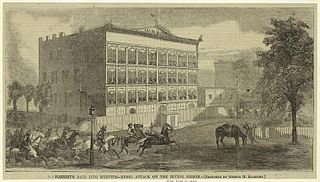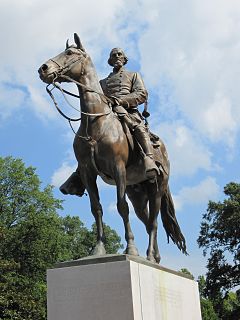
Nathan Bedford Forrest was a prominent Confederate Army general during the American Civil War and the first Grand Wizard of the Ku Klux Klan from 1867 to 1869. Before the war, Forrest amassed substantial wealth as a cotton plantation owner, horse and cattle trader, real estate broker, and slave trader. In June 1861, he enlisted in the Confederate Army and became one of the few soldiers during the war to enlist as a private and be promoted to general without any prior military training. An expert cavalry leader, Forrest was given command of a corps and established new doctrines for mobile forces, earning the nickname "The Wizard of the Saddle". His methods influenced future generations of military strategists, although the Confederate high command is seen by some commentators to have underappreciated his talents. Although scholars generally acknowledge Forrest's skills and acumen as a cavalry leader and military strategist, he has remained a controversial figure in Southern racial history for his main role in the massacre of several hundred Union soldiers at Fort Pillow, a majority of them black, coupled with his role following the war as a leader of the Klan.

Nathan Bedford Forrest III was a brigadier general of the United States Army Air Forces, and a great-grandson of Confederate general Nathan Bedford Forrest. He was killed in action in Germany during World War II. Forrest was the first American general to be killed in action during the war in Europe.

Fort Pillow State Historic Park is a state park in western Tennessee that preserves the American Civil War site of the Battle of Fort Pillow. The 1,642 acre (6.6 km²) Fort Pillow, located in Lauderdale County on the Chickasaw Bluffs overlooking the Mississippi River, is rich in both historic and archaeological significance. In 1861, the Confederate army built extensive fortifications and named the site for General Gideon Johnson Pillow of Maury County. It was attacked and held by the Union Army for most of the American Civil War period except immediately after the Battle of Fort Pillow, when it was retaken by the Confederate Army. The battle ended with a massacre of African-American Union troops and their white officers attempting to surrender, by soldiers under the command of Confederate Major General Nathan Bedford Forrest. Interpretive sites are part of the park.

Nathan Bedford Forrest State Park is a state park in Benton County, Tennessee, in the southeastern United States. The park is situated on the western shore of the Kentucky Lake impoundment of the Tennessee River, just north of the community of Eva. Established in 1929, the park consists of 2,587 acres (10.47 km2) managed by the Tennessee Department of Environment and Conservation.

The Battle of Fort Pillow, also known as the Fort Pillow massacre, was fought on April 12, 1864, at Fort Pillow on the Mississippi River in Henning, Tennessee, during the American Civil War. The battle ended with a massacre of Union soldiers attempting to surrender, by soldiers under the command of Confederate Major General Nathan Bedford Forrest. Military historian David J. Eicher concluded: "Fort Pillow marked one of the bleakest, saddest events of American military history."
The Battle of Johnsonville was fought November 4–5, 1864, in Benton County, Tennessee and Humphreys County, Tennessee, during the American Civil War. Confederate cavalry commander Major General Nathan Bedford Forrest culminated a 23-day raid through western Tennessee by attacking the Union supply base at Johnsonville. Forrest's attack destroyed numerous boats in the Tennessee River and millions of dollars of supplies, disrupting the logistical operations of Union Major General George H. Thomas in Nashville. As a result, Thomas's army was hampered in its plan to defeat Confederate Lieutenant General John Bell Hood's invasion of Tennessee, the Franklin-Nashville Campaign.

The Second Battle of Memphis was a battle of the American Civil War occurring on August 21, 1864, in Shelby County, Tennessee.

Streight's Raid took place in northern Alabama during the American Civil War. It was led by Union Army Col. Abel Streight and opposed by Confederate Brig. Gen. Nathan Bedford Forrest. Streight's goal was to destroy parts of the Western and Atlantic Railroad, which was supplying the Confederate Army of Tennessee. The raid was poorly supplied and planned, and ended with the defeat of Streight and his 1,700 men at Cedar Bluff, Alabama, by Forrest who bluffed his opponent into surrendering to his 500 men. Streight was additionally hindered by locals throughout his march, while pursued by Forrest, who had the advantage of home territory and the sympathy and aid of the local populace, most famously Emma Sansom.

Oaklands is a historic plantation home and house museum located in Murfreesboro, Tennessee, United States. Oaklands is on the National Register of Historic Places and is a local landmark known for its unique Italianate design.

Fort Wright was constructed in 1861 and located on the second Chickasaw Bluff at Randolph, Tipton County, Tennessee. Fort Wright was a Civil War fortification and the first military training facility of the Confederate Army in Tennessee.

Forrest's Cavalry Corps was part of the Confederate States Army during the American Civil War and commanded by Lieutenant General Nathan Bedford Forrest. Formed during the summer of 1862, it took part in the various battles in the Western Theater during the second half of the war. At first serving as part of the Army of Tennessee, both Forrest and the corps were then transferred to northern Mississippi and often launched independent raids into Union occupied western and central Tennessee.

John Ragan is a Republican member of the Tennessee House of Representatives, for the 33rd District, encompassing parts of Anderson County, Tennessee.

Nathan Bedford Forrest II was an American businessman who served as the 19th Commander-in-Chief of the Sons of Confederate Veterans from 1919 to 1921, and as the Grand Dragon of the Ku Klux Klan for Georgia. Forrest was born in Oxford, Mississippi, in 1871. His grandfather, Nathan Bedford Forrest, was a senior officer of the Confederate States Army who commanded cavalry in the Western Theater of the American Civil War. His only son, Nathan Bedford Forrest III, was a senior officer of the United States Army Air Forces killed in action in the European Theater of World War II.

George Tucker Stainback was an American classicist and Presbyterian minister; he served as a chaplain in the Confederate Army, and in 1877 presided over the funeral of Confederate general Nathan Bedford Forrest.

John Allan Wyeth was an American Confederate veteran and surgeon. Born and raised on a Southern plantation in Alabama, he served in the Confederate States Army and completed his medical studies in New York City and Europe. He became a surgeon in New York City, where he founded the New York Polyclinic Graduate Medical School and Hospital, a medical school. He served as the president of the American Medical Association in 1902. He was the author of a biography of Confederate General Nathan Bedford Forrest. He was a proponent of the annexation of Mexico by the United States.

John Watson Morton was an American Confederate veteran, farmer and politician. He served as captain of artillery under General Nathan Bedford Forrest in the Confederate States Army during the American Civil War, and he was the founder of the Nashville chapter of the Ku Klux Klan after the war. He served as the Tennessee Secretary of State from 1901 to 1909.

The Nathan Bedford Forrest Monument is a bronze sculpture by Charles Henry Niehaus, depicting a mounted General Nathan Bedford Forrest wearing a uniform of the Confederate States Army. It was formerly installed in Forrest Park in Memphis, Tennessee. The statue was cast in Paris. Forrest and his wife are buried in front of the monument, after being moved there from Elmwood Cemetery in a ceremony on November 11, 1904. The cornerstone for the monument was laid on May 30, 1901 and the monument was dedicated on May 16, 1905. It was removed on December 20, 2017 and is currently in the possession of the Sons of Confederate Veterans. Plans are for the statue to be re-erected on the grounds of the SCV National Headquarters in Columbia, Tennessee.

The Nathan Bedford Forrest Statue is a 20 feet (6.1 m) tall statue of Confederate General Nathan Bedford Forrest on a horse in Nashville, Tennessee, located near Interstate 65 at 701D Hogan Road. The statue depicts Forrest shooting behind himself and is flanked by Confederate battle flags. It is generally considered aesthetically unappealing due to its abnormal facial features, which bear little resemblance to Forrest himself, and more resemble a screaming deformed man.
For the statue in Nashville, see Nathan Bedford Forrest Statue.For the statue in Memphis, see Nathan Bedford Forrest Monument.

The Nathan Bedford Forrest Boyhood Home is a historic log house in Chapel Hill, Tennessee, U.S.. It was the childhood home of Confederate General Nathan Bedford Forrest from 1830 to 1833. It is owned by the Sons of Confederate Veterans.

















